
Handbook of Corporate Performance Management
John Wiley & Sons Inc (Hersteller)
978-1-119-28347-8 (ISBN)
- Titel wird leider nicht erscheinen
- Artikel merken
Case studies of individuals from widely differing organisations, who have all delivered great results, illustrate the importance of good leadership in creating a culture of high performance. The Handbook of Corporate Performance Management is the essential guide to using performance measurement and management to get the best out of your business.
Mike Bourne is Professor of Business Performance and Director of the Centre for Business Performance at Cranfield University's School of Management. Before joining academia, Mike spent 15 years in business, with roles in production management, strategy and acquisitions, HR, and general management. He gained his PhD from the University of Cambridge. His current research focuses on corporate performance measurement and management and he has spent the last fifteen years working with companies supporting senior management teams through the process of designing, implementing and using performance management techniques. he has worked with, and been consulted by, a number of organizations including Accenture, Amadeus, BAe Systems, DB Schenker, European central Bank, Lloyds SB, McCormick Europe, NHBC, Oki Europe, PWC, Schering, Thales, tube Lines and Unilever. He has authored over 100 publications and speaks international on the theme of business performance. Pippa Bourne is regional Director for ICAEW, the membership organisation supporting Chartered Accountants around the world. She has an MBA and is a chartered marketer and has experience in marketing and general management roles. In her early business career she held marketing roles in research and analysis. Following this she ran a number of successful profit centres within a university and professional bodies. she used the Balanced Scorecard to enable a culture change within one of these organisations, refocusing the business and improving performance. She is the co-author of Balanced Scorecard - Instant Manager, Balanced Scorecard in a Week, Achieving High Performance, Motivating People and change Management in a Week, and was an editor of the journal Measuring Business Excellence.
Preface xi Acknowledgements xiii Introduction xv 1. Performance and the Role of Measurement 1 1.1 Introduction 1 1.2 What is good performance? 1 1.3 Whose perspective? 1 1.4 Making comparisons 2 1.5 Present success and future sustainability 3 1.6 How is performance delivered? 3 1.7 The roles of a performance measurement system 5 1.8 The focus of measurement 7 1.9 The role of management and leadership 9 1.10 In summary 10 Further reading 10 2. Practical Tools for Measuring Performance 13 2.1 Introduction 13 2.2 Elements of a performance measurement system 13 2.3 The Balanced Scorecard 15 2.4 The Performance Prism 19 2.5 Objectives and success maps 20 2.6 Designing measures 24 2.7 Summary 30 Further reading 31 3. Designing the System 33 3.1 Introduction 33 3.2 A four phase life cycle 33 3.3 Design 34 3.4 How is this done in practice? 34 3.5 The debate 35 3.6 Developing the success map 37 3.7 Developing the measures 39 3.8 The next stage 40 Further reading 40 4. Managing Implementation 41 4.1 Introduction 41 4.2 Phases of implementation 41 4.3 Why does implementation succeed or fail? 41 4.4 Hurdles and blockers 45 4.5 Steps to successful implementation 46 4.6 Conclusion 48 Further reading 48 5. Assessing and Managing Change 51 5.1 Introduction 51 5.2 Change in context 51 5.3 Assessing resistance to change 53 5.4 Return on management 54 5.5 Assessing likelihood of implementation 55 5.6 Conclusion 58 Further reading 58 6. Target Setting 59 6.1 Introduction 59 6.2 Why do you set targets? 59 6.3 Ten common problems 60 6.4 The target setting wheel 62 6.5 Closing remark 65 Further reading 65 7. Linking Rewards to Performance 67 7.1 Introduction 67 7.2 Pitfalls 67 7.3 Linking rewards to performance 71 7.4 Examples 75 7.5 Summary 78 Further reading 78 8. Managing with Measures Statistical Process Control 81 8.1 Introduction 81 8.2 Variation and our reaction 81 8.3 Statistical process control 83 8.4 Performance and performance improvement 91 Further reading 92 9. Using Measures Performance Reviews 93 9.1 Introduction 93 9.2 The Performance planning value chain 93 9.3 Performance reviews 99 Further reading 104 10. Using Measures to Manage Challenging Strategy 105 10.1 Introduction 105 10.2 Company examples 105 10.3 Testing success maps in practice 109 10.4 Testing in theory and practice 113 10.5 Behavioural issues 117 10.6 Conclusion 118 Further reading 118 11. Keeping Your Measurement Process up to Date 119 11.1 Introduction 119 11.2 Keeping the process up to date 119 11.3 When do you update targets? 119 11.4 Revising measures 122 11.5 Reviewing the measures in line with your success map 123 11.6 Reflecting on your strategy 124 11.7 Challenging strategy 125 11.8 Overcoming barriers to updating your system 126 11.9 Summary 133 Further reading 133 12. Measuring Performance of People 135 12.1 Introduction 135 12.2 Essential elements for high performance 135 12.3 Measuring employee satisfaction and engagement 136 12.4 Performance appraisals 141 12.5 HR performance measures 145 12.6 Acting on results 147 Further reading and sources of information 147 13. Measuring Customers 149 13.1 Introduction 149 13.2 What are you measuring? 149 13.3 Using customer feedback 157 13.4 Summary 160 Further reading 161 14. Measuring Process Performance 163 14.1 Introduction 163 14.2 A process framework 163 14.3 Process measurement 164 14.4 Key process measures 165 14.5 Summary 169 Further reading 169 15. Measuring Competence and Resource Development 171 15.1 Introduction 171 15.2 Defining terms 171 15.3 Why measure resource and competence development? 172 15.4 A framework for displaying the relationship between resources and competences 176 15.5 Conclusion 183 Further reading 184 16. Measuring Financial Performance 185 16.1 Introduction 185 16.2 A shareholder perspective 186 16.3 Key shareholder ratios 189 16.4 Accounting ratios 191 16.5 Management ratios 194 16.6 Conclusion 196 Further reading 196 17. Measuring Sustainability 197 17.1 Introduction 197 17.2 What are sustainability and corporate responsibility ? 197 17.3 What are the benefits? 199 17.4 Building sustainability into your business 201 17.5 Conclusion 206 Further reading and sources of information 206 18. Creating a Culture of High Performance 209 18.1 Introduction 209 18.2 Creating the right environment 209 18.3 Creating the right culture 210 18.4 Recruiting the right people 212 18.5 What motivates? 214 18.6 Dealing with underperformers 215 18.7 Understanding your influence 216 18.8 Direction setting and engagement 217 18.9 Communication 218 18.10 Conclusion 219 Further reading 219 19. Leadership Vignettes 221 19.1 Introduction 221 19.2 Paul Woodward Chief Executive, Sue Ryder Care 221 19.3 PY Gerbeau Chief Executive, X-Leisure 223 19.4 Richard Boot OBE IRC Global Executive Search Partners 225 19.5 David Child 227 19.6 Baroness Sally Greengross 229 19.7 Charles Carter 231 19.8 Nigel Bond CEO, Domino Printing Sciences 232 19.9 Mark Lever CEO, National Autistic Society 236 19.10 Mike Ophield 239 19.11 Andy Wood Chief Executive, Adnams plc 242 20. Bringing It All Together 245 20.1 Introduction 245 20.2 Performance measurement 245 20.3 Performance management 246 20.4 Performance leadership 248 Further reading 251 Index 253
| Erscheint lt. Verlag | 30.11.2016 |
|---|---|
| Verlagsort | New York |
| Sprache | englisch |
| Maße | 152 x 229 mm |
| Themenwelt | Wirtschaft ► Betriebswirtschaft / Management ► Logistik / Produktion |
| ISBN-10 | 1-119-28347-7 / 1119283477 |
| ISBN-13 | 978-1-119-28347-8 / 9781119283478 |
| Zustand | Neuware |
| Haben Sie eine Frage zum Produkt? |
aus dem Bereich


